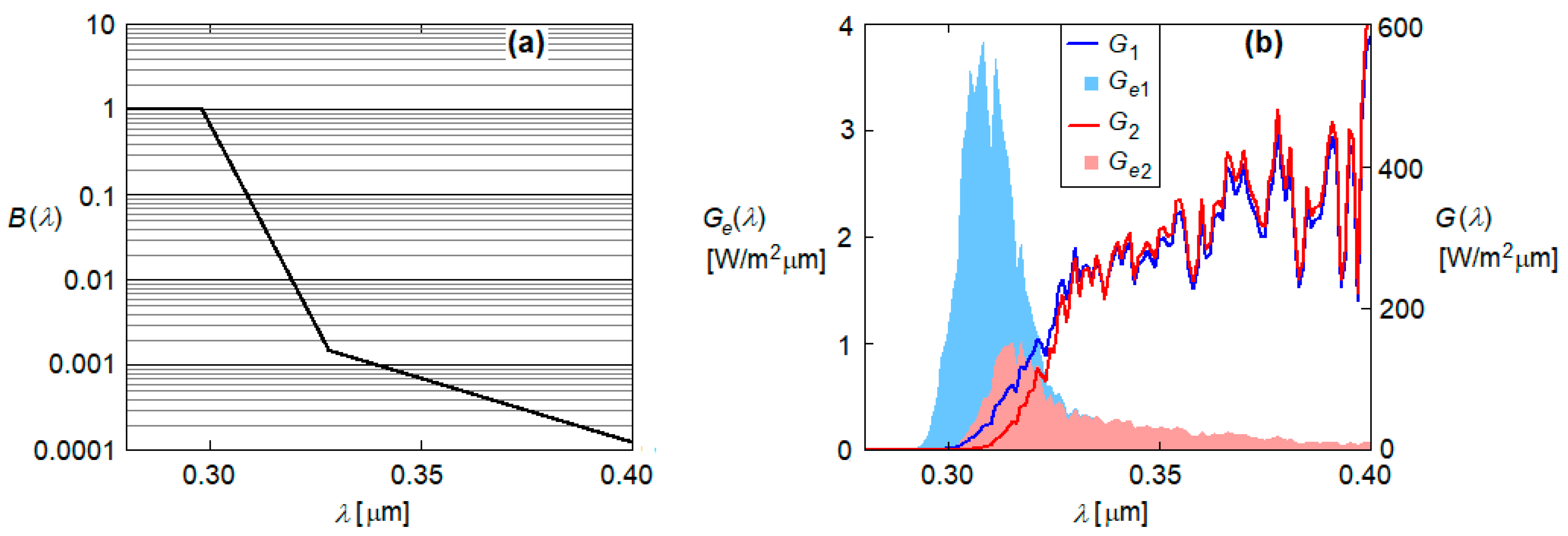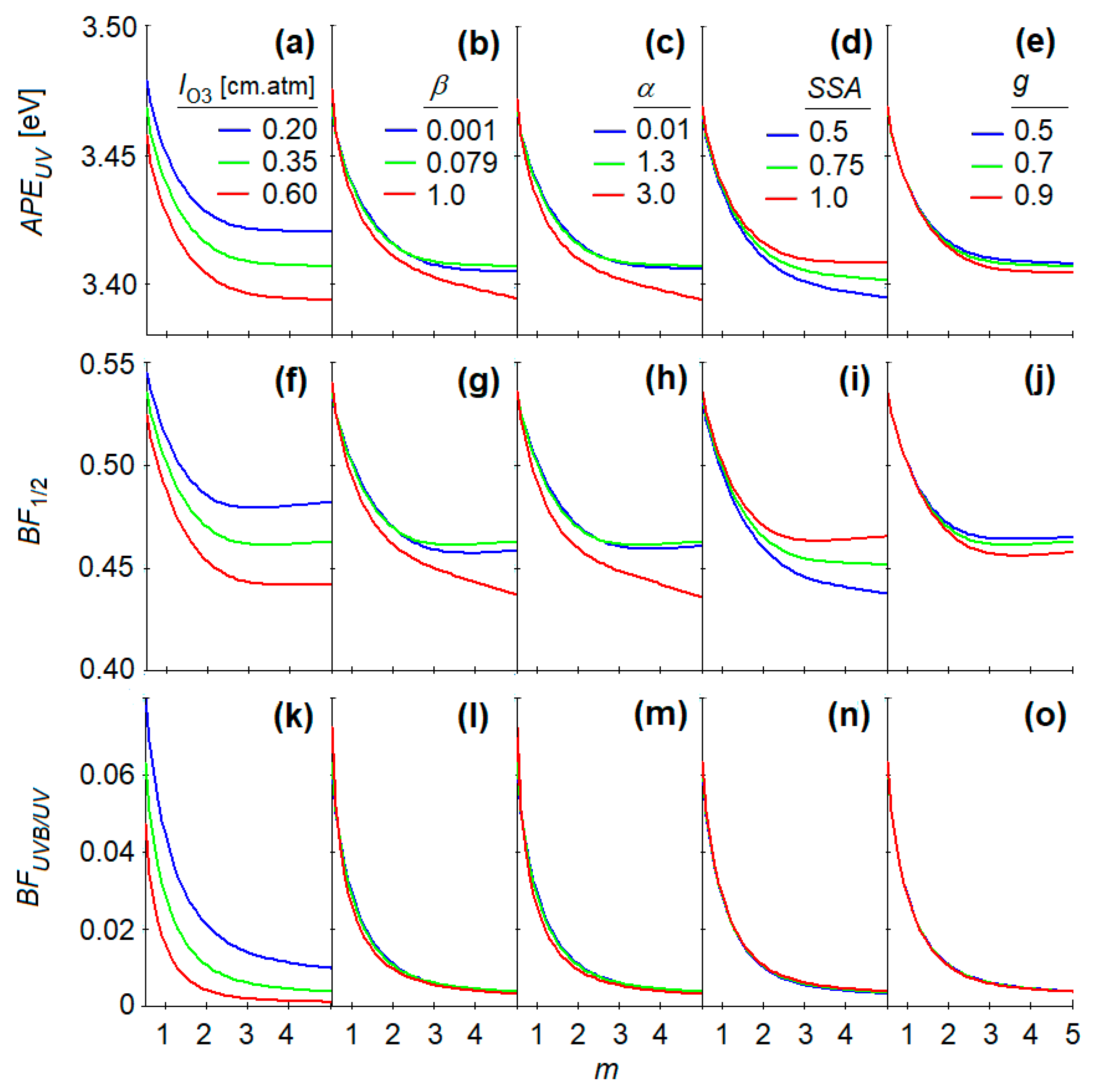Identifying the Signature of the Solar UV Radiation Spectrum
Abstract
1. Introduction
2. Signatures of Solar Radiation Spectrum
3. Results and Discussions
3.1. Proposal for Signatures of the Solar Radiation Spectrum in the UV Band
- 1.
- APEUV is defined by Equation (1), where the integration domain was restricted to the UV band and .
- 2.
- BF1/2 is defined by Equation (2), with . This proposal emerges naturally, as divides the reference UV spectrum into two equal parts in terms of energy. BF1.2 > 1 indicates a blueshift in the UV spectrum, while BF1/2 < 1 indicates a redshift.
- 3.
- BFUVB/UV is also defined by Equation (2), but with . BFUVB/UV captures the specificity of the UV band, being defined as the fraction of the energy of solar UV radiation held by UV-B.
3.2. Synthetic UV Spectra
3.3. Sensitivity Analysis
3.4. Uniqueness
- The spectra of solar UV radiation were generated by varying the atmospheric parameters in Equation (7), aiming to cover the atmospheric conditions found in the actual measurements. More precisely, the spectra were generated considering the following values of the atmospheric parameters: 9 values for atmospheric optical mass, from m = 1 to m = 5 with a step of 0.5; 6 for the ozone column content from lO3 = 0.3 cm·atm to lO3 = 0.55 cm·atm with a step of 0.5 cm·atm; 10 for the Ångström turbidity coefficient, from β = 0.02 to β = 0.2; 8 for the Ångström exponent, from α = 0.1 to α = 2.9 with a step of 0.4; 6 for the single scattering albedo, from SSA = 0.7 to SSA = 1 with a step of 0.05. Thus, a total of 25,920 solar UV spectra were generated.
- The BFUVB/UV index was calculated for each spectrum, retaining only the first three decimal places. The 25,920 spectra show 34 distinct signatures between 0.000 and 0.033.
- To evaluate how different (in terms of energy distribution) the spectra that have the same sign are, the UV band, 0.28 … 0.4 µm, was divided into 24 disjoint spectral bands, each with a 5 nm width. For each spectrum, the percentage P [%] of the total irradiance from each spectral band was calculated.
- The spectra were distributed in 34 bins according to their signatures (from BFUVB/UV = 0.000 to BFUVB/UV = 0.033). In other words, each bin contains only spectra that have the same signature. The number of spectra differs significantly from one bin to another, decreasing with an increasing BFUVB/UV. The first bins (BFUVB/UV < 0.06) contain over 2000 spectra, the middle bins contain hundreds of spectra, and the bins at the other end (BFUVB/UV > 0.29) contain only tens of spectra.
- Finally, for each signature (or bin), the distribution of P in each of the 24 spectral bands was analyzed.
4. Conclusions
Author Contributions
Funding
Institutional Review Board Statement
Informed Consent Statement
Data Availability Statement
Conflicts of Interest
References
- Cottin, H.; Kotler, J.M.; Billi, D.; Cockell, C.; Demets, R.; Ehrenfreund, P.; Elsaesser, A.; d’Hendecourt, L.; van Loon, J.J.W.A.; Martins, Z.; et al. Space as a Tool for Astrobiology: Review and Recommendations for Experimentations in Earth Orbit and Beyond. Space Sci. Rev. 2017, 209, 83–181. [Google Scholar] [CrossRef]
- Ahmad, S.I. (Ed.) Ultraviolet Light in Human Health, Diseases and Environment; Springer: Cham, Switzerland, 2017. [Google Scholar] [CrossRef]
- Ballare, C.L.; Caldwell, M.M.; Flint, S.D.; Robinson, S.A.; Bornman, J.F. Effects of solar ultraviolet radiation on terrestrial ecosystems. Patterns, mechanisms, and interactions with climate change. Photochem. Photobiol. Sci. 2011, 10, 226–241. [Google Scholar] [CrossRef] [PubMed]
- Tang, X.; Yang, T.; Yu, D.; Xiong, H.; Zhang, S. Current insights and future perspectives of ultraviolet radiation (UV) exposure: Friends and foes to the skin and beyond the skin. Environ. Int. 2024, 185, 108535. [Google Scholar] [CrossRef] [PubMed]
- Pitts, D.G.; Cullen, A.P.; Hacker, P.D. Ocular effects of ultraviolet radiation from 295 to 365 nm. Investig. Ophthalmol. Vis. Sci. 1977, 16, 932–939. [Google Scholar]
- Farr, P.M.; Diffey, B.L. The erythemal response of human skin to ultraviolet radiation. Brit. J. Dermatol. 1985, 113, 65–76. [Google Scholar] [CrossRef]
- McKinlay, A.F.; Diffey, B.L. A reference spectrum for ultraviolet induced erythema in human skin. CIE J. 1987, 6, 17–22. [Google Scholar]
- Webb, A.R.; Slaper, H.; Koepke, P.; Schmalwieser, A.W. Know Your Standard: Clarifying the CIE Erythema Action Spectrum. Photochem. Photobiol. 2011, 87, 483–486. [Google Scholar] [CrossRef]
- Chubarova, N.E.; Pastukhova, A.S.; Zhdanova, E.Y.; Volpert, E.V.; Smyshlyaev, S.P.; Galin, V.Y. Effects of Ozone and Clouds on Temporal Variability of Surface UV Radiation and UV Resources over Northern Eurasia Derived from Measurements and Modeling. Atmosphere 2020, 11, 59. [Google Scholar] [CrossRef]
- Bencherif, H.; Toihir, A.M.; Mbatha, N.; Sivakumar, V.; du Preez, D.J.; Bègue, N.; Coetzee, G. Ozone Variability and Trend Estimates from 20-Years of Ground-Based and Satellite Observations at Irene Station, South Africa. Atmosphere 2020, 11, 1216. [Google Scholar] [CrossRef]
- Zhao, S.; Xin, H.; Wu, S.; Sun, Y.; Hu, B. Attenuation of Ultraviolet Radiation by Aerosols and Clouds in Beijing Area in 2005–2020. Atmosphere 2024, 15, 311. [Google Scholar] [CrossRef]
- Paulescu, M.; Stefu, N.; Tulcan-Paulescu, E.; Calinoiu, D.; Neculae, A.; Gravila, P. UV solar irradiance from broadband radiation and other meteorological data. Atmos. Res. 2010, 96, 141–148. [Google Scholar] [CrossRef]
- Habte, A.; Sengupta, M.; Gueymard, C.A.; Narasappa, R.; Rosseler, O.; Burns, D.M. Estimating Ultraviolet Radiation from Global Horizontal Irradiance. IEEE J. Photovolt. 2019, 9, 139–146. [Google Scholar] [CrossRef]
- Paulescu, E.; Stefu, N.; Gravila, P.; Boata, R.S.; Pop, N.; Paulescu, M. Procedure of embedding biological action functions into the atmospheric transmittance. Theor. Appl. Climatol. 2012, 109, 323–332. [Google Scholar] [CrossRef]
- Malinovic, S.; Mihailovic, D.T.; Kapor, D.V.; Mijatovic, Z.; Arsenic, I. NEOPLANTA: A Short Description of the First Serbian UV Index Model. J. Appl. Meteorol. Climatol. 2006, 45, 1171–1177. [Google Scholar] [CrossRef]
- Gueymard, C.A. Assessment of the global applicability of three leading indices that characterize the spectral distribution of solar irradiance impacting various photovoltaic technologies. Energy Convers. Manag. 2023, 295, 117602. [Google Scholar] [CrossRef]
- Daxini, R.; Wu, Y. Review of methods to account for the solar spectral influence on photovoltaic device performance. Energy 2024, 286, 129461. [Google Scholar] [CrossRef]
- Chantana, J.; Imai, Y.; Kawano, Y.; Hishikawa, Y.; Nishioka, K.; Minemoto, T. Impact of average photon energy on spectral gain and loss of various-type PV technologies at different locations. Renew. Energy 2020, 145, 1317–1324. [Google Scholar] [CrossRef]
- Minemoto, T.; Nakada, Y.; Takahashi, H.; Takakura, H. Uniqueness verification of solar spectrum index of average photon energy for evaluating outdoor performance of photovoltaic modules Sol. Energy 2009, 83, 1294. [Google Scholar]
- Nofuentes, G.; Gueymard, C.A.; Aguilera, J.; Perez-Godoy, M.D.; Charte, F. Is the average photon energy a unique characteristic of the spectral distribution of global irradiance? Sol. Energy 2017, 149, 32–43. [Google Scholar] [CrossRef]
- Kollias, N.; Ruvolo, E., Jr.; Sayre, R.M. The Value of the Ratio of UVA to UVB in Sunlight. Photochem. Photobiol. 2011, 87, 1474–1475. [Google Scholar] [CrossRef]
- Gueymard, C.A. SMARTS2 A Simple Model of the Atmospheric Radiative Transfer of Sunshine: Algorithms and Performance Assessment. Florida Solar Energy Center Report. 1995; FSEC-PF-270-95. Available online: https://www.nrel.gov/grid/solar-resource/smarts.html (accessed on 1 March 2025).
- Gueymard, C.A. The SMARTS spectral irradiance model after 25 years: New developments and validation of reference spectra. Sol. Energy 2019, 187, 233–253. [Google Scholar] [CrossRef]
- Kasten, F.; Young, A. Revised optical air mass tables and approximation formula. Appl. Opt. 1989, 28, 4735–4738. [Google Scholar] [PubMed]
- Blaga, R.; Calinoiu, D.; Paulescu, M. A one-parameter family of clear-sky solar irradiance models adapted for different aerosol types. J. Renew. Sustain. Energy 2021, 13, 023701. [Google Scholar]





Disclaimer/Publisher’s Note: The statements, opinions and data contained in all publications are solely those of the individual author(s) and contributor(s) and not of MDPI and/or the editor(s). MDPI and/or the editor(s) disclaim responsibility for any injury to people or property resulting from any ideas, methods, instructions or products referred to in the content. |
© 2025 by the authors. Licensee MDPI, Basel, Switzerland. This article is an open access article distributed under the terms and conditions of the Creative Commons Attribution (CC BY) license (https://creativecommons.org/licenses/by/4.0/).
Share and Cite
Codrean, A.-F.; Bunoiu, O.M.; Paulescu, M. Identifying the Signature of the Solar UV Radiation Spectrum. Atmosphere 2025, 16, 427. https://doi.org/10.3390/atmos16040427
Codrean A-F, Bunoiu OM, Paulescu M. Identifying the Signature of the Solar UV Radiation Spectrum. Atmosphere. 2025; 16(4):427. https://doi.org/10.3390/atmos16040427
Chicago/Turabian StyleCodrean, Andrea-Florina, Octavian Madalin Bunoiu, and Marius Paulescu. 2025. "Identifying the Signature of the Solar UV Radiation Spectrum" Atmosphere 16, no. 4: 427. https://doi.org/10.3390/atmos16040427
APA StyleCodrean, A.-F., Bunoiu, O. M., & Paulescu, M. (2025). Identifying the Signature of the Solar UV Radiation Spectrum. Atmosphere, 16(4), 427. https://doi.org/10.3390/atmos16040427







